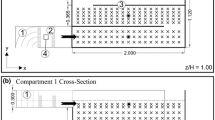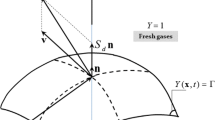Abstract
The disagreement between free surface scalar experiments and the two-dimensional (2D) transport equation is discussed. An effective diffusivity coefficient, \(\kappa _{{\rm eff}}\), is introduced and defined as the quotient between variance decay and mean gradient square. In all the experiments performed, \(\kappa _{{\rm eff}}\) is significantly larger than the scalar diffusivity, \(\kappa \). Three mechanisms are identified as responsible for the differences between the quasi two-dimensional (Q2D) experiments and the 2D behaviour of a diffusive scalar. These are the vertical velocity gradients, the free surface divergence and the gravity currents induced by the scalar. These mechanisms, which affect the diffusive term in the 2D transport equation for large Péclet number (\(Pe\gg 1\)), are evaluated for steady and time-dependant laminar flows driven by electromagnetic body forces.










Similar content being viewed by others
References
Amen R, Maxworthy T (1980) The gravitational collapse of a mixed region into a linearly stratified fluid. J Fluid Mech 96:65–80
Axelrod D, Koppel DE, Schlessinger J, Elson E, Webb WW (1976) Mobility measurement by analysis of fluorescence photobleaching recovery kinetics. Biophys J 16:1055–1069
Cenedesse C, Dalziel S (1998) Concentration and depth fields determined by the light transmitted through a dyed solution. In: Carlomagno GM, Grant I (eds) 8th international symposium on flow visualization, Sorrento, Italy, pp 61.1–61.5
Fay JA (1969) The spread of oil slicks on a Calm Sea. Plenum Press, New York
Fay JA (1971) Physical processes in the spread of oil on a water surface. In: A. P. Institute (ed) Proceedings of the joint conference on the prevention and control of oil spills, Washington, DC, pp 463–467
Garcia de la Cruz JM (2011) Experimental study of free surface mixing in vortical and chaotic flows. Ph.D. thesis, Imperial College, London
Gouillart E, Dauchot O, Thiffeault JL, Roux S (2009) Open-flow mixing: experimental evidence for strange eigenmodes. Phys Fluids 21:023603
Guilbault GG (1973) Practical fluorescence, 2nd edn. Marcel Dekker, New York
Hoult DP (1972) Oil spreading on the sea. Annu Rev Fluid Mech 4:341–368
Jana SC, Tjahjadi M, Ottino JM (1994) Chaotic mixing of viscous fluids by periodic changes in geometry: baffled cavity flow. Anal Chem E 40:1769–1781
Jullien MC (2003) Dispersion of passive tracers in the direct enstrophy cascade: experimental observations. Phys Fluids 15:2228–2237
Jullien MC, Castiglione P, Tabeling P (2000) Experimental observation of batchelor dispersion of passive tracers. Phys Rev Lett 85:3636–3639
Raffel M, Willert C, Wereley S, Kompenhans J (1998) Particle image velocimetry. Springer, Berlin
Rossi L, Bocquet S, Ferrari S, Garcia de la Cruz JM, Lardeau S (2009) Control of flow geometry using electromagnetic body forcing. Int J Heat Fluid Flow 30:505–513
Rossi L, Doorly D, Kustrin D (2012) Lamination and mixing in laminar flows driven by Lorentz body forces. Europhys Lett 97:14006
Rossi L, Vassilicos JC, Hardalupas Y (2006) Electromagnetically controlled multi-scale flows. J Fluid Mech 558:207–241
Rothstein D, Henry E, Gollub JP (1999) Persistent patterns in transient chaotic fluid mixing. Nature 401:770–772
Ungarish M, Huppert HE (2004) On gravity currents propagating at the base of a stratified ambient: effects of geometrical constraints and rotation. J Fluid Mech 521:69–104
Voth GA, Haller G, Gollub JP (2002) Experimental measurements of stretching fields in fluid mixing. Phys Rev Lett 88:254501
Voth GA, Saint TC, Dobler G, Gollub JP (2003) Mixing rates and symmetry breaking in two-dimensional chaotic flow. Phys Fluids 15:2560–2566
Warhaft Z (2000) Passive scalars in turbulent flows. Annu Rev Fluid Mech 32:203–240
Weast RC (1989) Handbook of chemistry and physics: a ready-reference book of chemical and physical data, 70th edn. CRC Press, Boca Raton
Williams BS, Marteau D, Gollub JP (1997) Mixing of a passive scalar in magnetically forced two-dimensional turbulence. Phys Fluids 9:2061–2080
Wolf AV (1966) Aqueous solutions and body fluids. Harper and Row, New York
Wu J (1969) Mixed region collapse with internal wave generation in a density-stratified medium. J Fluid Mech 35:531–544
Author information
Authors and Affiliations
Corresponding author
Rights and permissions
About this article
Cite this article
García de la Cruz, J.M., Rossi, L. & Vassilicos, J.C. Three-dimensional effects in quasi two-dimensional free surface scalar experiments. Exp Fluids 55, 1835 (2014). https://doi.org/10.1007/s00348-014-1835-0
Received:
Revised:
Accepted:
Published:
DOI: https://doi.org/10.1007/s00348-014-1835-0




